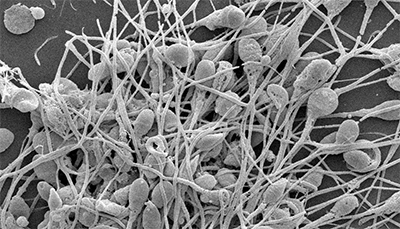From the journals: May 2019
We offer a selection of recent papers on a variety of topics from the Journal of Biological Chemistry, the Journal of Lipid Research and Molecular & Cellular Proteomics.
Peering into Alzheimer’s protein aggregation
The hereditary Arctic mutation of 42-amino-acid beta-amyloid peptide, known as Abeta42, causes aggressive aggregation of the peptide in early-onset Alzheimer’s disease. The mechanism connecting this mutation to the protein accumulation is unknown, however. Meng Lu and colleagues at the University of Cambridge revealed details of this process by establishing stable cell lines expressing the mutation and observing them with fluorescence-lifetime and super-resolution imaging. They found that Arctic mutant Abeta42 formed five unique types of aggregates that degraded more slowly than those in wild-type cells. The authors suggest their model lays groundwork for studying how intracellular amyloid affects cellular compartments. The study was published in the Journal of Biological Chemistry.
Advancing phage proteomics
Bacteriophages, or phages, are viruses that infect bacteria, and they are ubiquitous across the planet. Phage studies have provided fundamental knowledge for the development of molecular biology and important biotechnologies such as the CRISPR-Cas system.
Researchers are working to unravel crucial aspects of phage biology, including the phage and bacterial proteome during infection. Transcriptomic and metabolomic studies have been conducted to analyze gene expression during phage infection, but proteomic analysis is required to understand how gene expression is regulated post-transcription.
In a paper published in Molecular & Cellular Proteomics, Marie-Laurence Lemay and colleagues from Laval University in Quebec City describe how they used high-throughput proteomics techniques to characterize the viral and bacterial proteomes at different stages of infection. They identified several bacterial proteins that were expressed only during infection. Their results also generated a more comprehensive view of the phage proteome that will be important for future studies of phage biology.
Signal transduction in sperm development
 This scanning electron micrograph shows human spermatozoa at 2,500 times magnification.Enver Kerem Dirican/Wikimedia CommonsSpermatogenesis is a highly regulated cell differentiation process that gives rise to the male gamete known as the sperm cell. This process takes place within the seminiferous tubules of the testis. During the last step of the cell differentiation process, the developing gametes undergo a number of structural changes in which they elongate, lose most of their cytoplasm and gain important functional features such as the flagellum. The gametes then are released to continue their maturation process in the epididymis. Fertility deficiencies and offspring disorders can occur if any of the steps in spermatogenesis are disrupted.
This scanning electron micrograph shows human spermatozoa at 2,500 times magnification.Enver Kerem Dirican/Wikimedia CommonsSpermatogenesis is a highly regulated cell differentiation process that gives rise to the male gamete known as the sperm cell. This process takes place within the seminiferous tubules of the testis. During the last step of the cell differentiation process, the developing gametes undergo a number of structural changes in which they elongate, lose most of their cytoplasm and gain important functional features such as the flagellum. The gametes then are released to continue their maturation process in the epididymis. Fertility deficiencies and offspring disorders can occur if any of the steps in spermatogenesis are disrupted.
Previous studies of spermatogenesis have uncovered the hormone pathways that drive the differentiation process. However, other areas of regulation, such as signal transduction during sperm development, require further exploration. For instance, protein phosphorylation is a signaling event that plays a role in cell cycle regulation, cell death, cell differentiation and other critical biological pathways. Protein phosphorylation has been identified as a crucial player in regulation of testis-specific events.
In a paper published in Molecular & Cellular Proteomics, Judit Castillo and colleagues from Lead Pharma and the OncoProteomics Laboratory in the Netherlands performed phosphoproteomics studies using human testicular tissue to identify important signaling events during spermatogenesis. They coupled metal oxide affinity chromatography with mass spectrometry to generate a profile of the human testis phosphoproteome that included 174 phosphorylated kinases. They used their data to identify the most active kinases in the human testis, such as cyclin-dependent kinase 12 and p21-activated kinase 4, which function in splicing regulation and cell survival, respectively. In the future, their findings may be used to validate targets for drug development for male fertility and testicular tumors.
— Kerri Beth Slaughter
Up close and personal with ribosomes
The ability to visualize macromolecular structures of single cells could aid understanding of a host of cellular activities. However, current methods are limited by low resolution and the requirement for highly purified samples. Xiunan Yi and colleagues at the University of Texas present a new technique that combines single-cell lysis with electron microscopy. In their report in the Journal of Biological Chemistry, they write that they used this method to image and count ribosomes of single Caenorhabditis elegans embryos throughout several stages of development. The authors conclude that this method holds significant promise for applications in developmental, evolutionary and disease-related studies.
High fructose diet and metabolic syndrome
Have you looked at the sugar content on your favorite soft drink or juice? Soft drinks and juices are high in fructose. A high-fructose diet can lead to dyslipidemia and is a major risk factor for development of cardiovascular disease, or CVD, and insulin resistance. Andrew Butler at Saint Louis University, in collaboration with researchers at the University of California, Davis, studied the role of fructose-fed diet in developing CVD. In a paper published in the Journal of Lipid Research, they write that they fed rhesus monkeys beverages sweetened with fructose-containing sugar and measured plasma lipid profiles as well as lipidomic changes. They were the first researchers to show a positive correlation between high fructose consumption and an increase in the quantity of large lipoprotein particles such as very-low density lipoproteins, known as VLDLs, that are associated with CVD. Furthermore, they showed that administration of fish oil reversed the increased shift in the quantity of large lipoprotein particles. They showed a strong correlation between concentration of plasma ApoC3, a protein component of VLDLs, and elevation in the number of VLDLs. ApoC3 affects the metabolism of lipoproteins, and its expression is a risk factor for CVD. Next time, check the sugar content and think twice before you enjoy your favorite sweet drink.
Role of sphingosine in mitochondrial dysfunction and TBI
 Mitochondria, such as the one in this drawing, are the powerhouses of the cell. In this study, researchers show that sphingosine can disrupt mitochondrial function.Ian MacDonaldTraumatic brain injury, or TBI, is a public health concern in the developed world among young people who play contact sports and the elderly, who are prone to falling. Events after TBI can be separated into primary and secondary injuries. Primary injury occurs nearly instantly after TBI, while secondary injury begins usually within minutes or hours and includes events such as immune cell infiltration and activation, cytokine release and apoptosis. One secondary injury event is mitochondrial dysfunction. In a paper published in the Journal of Lipid Research, Sergei Novgorodov and colleagues at the University of South Carolina write about some mechanisms by which enzymes involved in sphingolipid metabolism lead to mitochondrial dysfunction and exacerbation of secondary injury after TBI.
Mitochondria, such as the one in this drawing, are the powerhouses of the cell. In this study, researchers show that sphingosine can disrupt mitochondrial function.Ian MacDonaldTraumatic brain injury, or TBI, is a public health concern in the developed world among young people who play contact sports and the elderly, who are prone to falling. Events after TBI can be separated into primary and secondary injuries. Primary injury occurs nearly instantly after TBI, while secondary injury begins usually within minutes or hours and includes events such as immune cell infiltration and activation, cytokine release and apoptosis. One secondary injury event is mitochondrial dysfunction. In a paper published in the Journal of Lipid Research, Sergei Novgorodov and colleagues at the University of South Carolina write about some mechanisms by which enzymes involved in sphingolipid metabolism lead to mitochondrial dysfunction and exacerbation of secondary injury after TBI.
Sphingolipids play important roles in cells. Some, such as sphingomyelins, are major building blocks of cellular membranes, while others, ceramides and sphingosine, are essential in cell proliferation, differentiation and programmed cell death. More than 40 enzymes in the brain metabolize sphingolipids. The researchers showed that events after TBI cause stimulation of one of these enzymes, called neutral ceramidase, or NCDase, leading to accumulation of mitochondrial sphingosine and eventually mitochondrial dysfunction exacerbating secondary injury.
To investigate the role of sphingosine in secondary brain injury, Novgorodov’s team examined NCDase-deficient mice and wild-type mice that underwent controlled cortical impact injury to reproduce the histological and pathological changes associated with human TBI. The NCDase-deficient mice had 37 percent lower levels of mitochondrial sphingosine in their injured brains than the wild-type mice. The finding that sphingolipids can cause mitochondrial dysfunction, which in turn can exacerbate neuroinflammation, could open new avenues for drug discovery.
— Gelareh Abulwerdi
Bacterial extracellular vesicles as virulent bombs
The bacterium Listeria monocytogenes is the cause of listeriosis, an illness that can present a major threat to pregnant women, newborns and others with weakened immune systems. This organism has been found to secrete tiny lipid-bilayered spheres called extracellular vesicles, or EVs, but their role in infection is not completely understood. Caroline Coelho at Johns Hopkins University and colleagues report in the Journal of Biological Chemistry that these EVs contain several virulence factors including the pore-forming toxin listeriolysin O. High-resolution fluorescence imaging captured real-time EV release from bacteria inside infected mammalian cells. The authors suggest that EVs are used for toxin release, which adds to the current understanding of L. monocytogenes’ pathogenic strategy.
Immunomic screening of the Plasmodium proteome
Malaria is caused by a single-celled eukaryotic parasite in the Plasmodium genus. This parasite is spread from mosquitoes to humans, particularly in tropical and subtropical regions of the world, leading to severe disease and sometimes death. No vaccine exists to prevent malaria, and drug resistance poses a major threat to fighting the infection.
Developing a malaria vaccine has proved challenging, and additional studies are needed to identify new parasite proteins associated with protection in humans. A limited number of malaria proteins have been investigated, and a more comprehensive screening of the malaria proteome using antibodies able to provide protection against infection could advance vaccine development.
In a paper published in Molecular & Cellular Proteomics, Anthony Siau and colleagues from the Nanyang Technological University in Singapore screening of the malaria proteome using antibodies able to provide protection against infection. After the initial screen, the researchers used predictive criteria to calculate the likelihood of protection for each antigen. Their proteomic techniques for studying protection provided a framework for the development of a new approach to malaria vaccine development.
Lipid profiles and chronic kidney disease
Data on the association between dyslipidemia and end-stage renal disease, the final stage of chronic kidney disease, are rare, and the results are not conclusive. Such data would be valuable for a medical practitioner putting a CKD patient on a drug regimen. Ching-Wei Tsai and colleagues at China Medical University performed a 13-year prospective study of more than 4,500 patients with CKD between the ages of 20 and 90 to find the association between lipid trajectories and risk of developing ESRD. In a paper published in the Journal of Lipid Research, Tsai and colleagues report that higher baseline levels of lipoproteins such as LDL cholesterol and total cholesterol correlated with higher risk of developing ESRD in patients with CKD. Overall, the incidence of ESRD in CKD patients with high baseline triglyceride was 49 percent higher.
 A reporter gene assay shows the response of tobacco BY-2 cells to the caryophyllene structural analog caryophyllene oxide. Nagashima et al.
A reporter gene assay shows the response of tobacco BY-2 cells to the caryophyllene structural analog caryophyllene oxide. Nagashima et al.
How plants sniff out danger
Plants cannot hear or see impending threats, but they can smell them. Volatile organic compounds, or VOCs, released by herbivore-infested plants can be sensed by other plants, which then, in response to the danger nearby, upregulate defense-related genes. While animals sense odors through membrane receptors in their nervous systems, the same receptors are rarer and have different jobs in plants. It seems likely that plants have their own unique way of sensing VOCs, but molecular mechanisms that could explain these olfactory processes have evaded researchers.
In a study published in the Journal of Biological Chemistry, Ayumi Nagashima and a team of researchers from across Japan have made a significant step toward understanding plant olfaction by showing that gene-suppressing TOPLESS-like proteins, or TPLs, are critical for tobacco plants’ sensing and responding to VOCs.
The researchers exposed tobacco cells to an array of VOCs and noticed that caryophyllene encouraged the expression of stress-responsive genes. To find which plant molecule was binding this VOC, they used a pulldown assay in which proteins extracted from tobacco leaves were incubated with caryophyllene-linked beads. After separating the beads from the extract with magnets and washing them, they found that TPLs remained bound to caryophyllene.
The role of TPLs in plant olfaction was probed further by overexpressing the protein in tobacco cells. After exposing these cells to caryophyllene, they found that the upregulation of defense-related genes was reduced, which could implicate TPLs in the response of plant gene expression to caryophyllene.
This study provides evidence for VOC sensing via a nuclear protein. Future studies could aim at illuminating the long-hidden mechanism underlying plant olfaction.
— Jonathan Griffin
A protein that propelled life toward multicellularity
The basement membrane, or BM, is an extracellular matrix component that is essential to tissue functions. BM played a key role in the evolutionary leap of unicellular organisms to multicellularity, but its exact structure and function during this ancient transition are unknown. Carl Darris and colleagues at Vanderbilt University now report that the BM protein Goodpasture antigen-binding protein, or GPBP, likely played a key role in this transition. By comparing the genomes of some metazoans and unicellular organisms, they found that GPBP-2 is the oldest isoform of GPBP and possibly functioned both intracellularly and extracellularly in early metazoans. The GPBP-1 isoform emerged later in chordates as an extracellular component, which the authors suggest likely allowed for the development of epithelial tissues. Their results were published in the Journal of Biological Chemistry.
Linking lipid transport to metabolic disease
Mutations in lipid transporting phospholipid flippases, or P4-ATPases, can lead to a variety of metabolic diseases, including insulin resistance and obesity. These mutants also have been associated with elevated levels of intracellular glucosylceramide, known as GlcCer, but how these lipids traverse cellular membranes is not well understood. In a study in the Journal of Biological Chemistry, Bartholomew Roland and colleagues from Vanderbilt University and Kyoto University confirmed that certain P4-ATPases play a direct role in GlcCer transport by observing uptake of fluorescently tagged GlcCer into yeast and human cells. They also found that a central glutamine of the TM4 transmembrane segment is required for GlcCer transport. The authors suggest that certain GlcCer-transporting P4-ATPases may be critical for lipid homeostasis and metabolism.
Enjoy reading ASBMB Today?
Become a member to receive the print edition four times a year and the digital edition monthly.
Learn moreGet the latest from ASBMB Today
Enter your email address, and we’ll send you a weekly email with recent articles, interviews and more.
Latest in Science
Science highlights or most popular articles

Using DNA barcodes to capture local biodiversity
Undergraduate at the University of California, Santa Barbara, leads citizen science initiative to engage the public in DNA barcoding to catalog local biodiversity, fostering community involvement in science.

Targeting Toxoplasma parasites and their protein accomplices
Researchers identify that a Toxoplasma gondii enzyme drives parasite's survival. Read more about this recent study from the Journal of Lipid Research.

Scavenger protein receptor aids the transport of lipoproteins
Scientists elucidated how two major splice variants of scavenger receptors affect cellular localization in endothelial cells. Read more about this recent study from the Journal of Lipid Research.

Fat cells are a culprit in osteoporosis
Scientists reveal that lipid transfer from bone marrow adipocytes to osteoblasts impairs bone formation by downregulating osteogenic proteins and inducing ferroptosis. Read more about this recent study from the Journal of Lipid Research.

Unraveling oncogenesis: What makes cancer tick?
Learn about the ASBMB 2025 symposium on oncogenic hubs: chromatin regulatory and transcriptional complexes in cancer.

Exploring lipid metabolism: A journey through time and innovation
Recent lipid metabolism research has unveiled critical insights into lipid–protein interactions, offering potential therapeutic targets for metabolic and neurodegenerative diseases. Check out the latest in lipid science at the ASBMB annual meeting.



